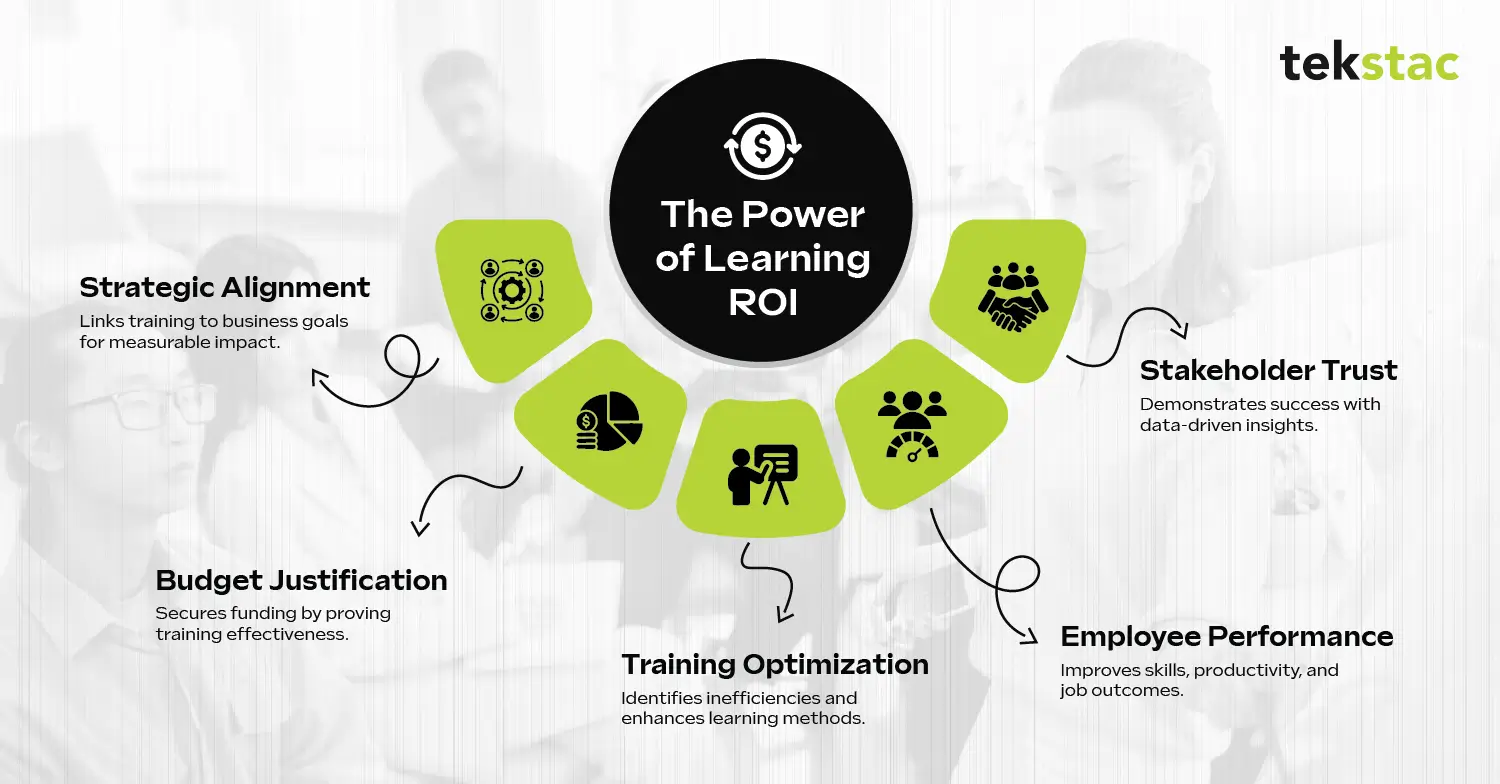Why Learning ROI Matters: How L&D Leaders Can Measure Success

What Is Learning ROI in Training Programs?
Organizations invest heavily in employee training programs to enhance skills, productivity, and growth. However, having programs is never enough; value needs to be measured, and this is where the concept of Learning ROI (Return on Investment) comes in.
Learning ROI is a metric that compares the benefits of training programs against their costs, showing how effectively learning initiatives contribute to business outcomes. When measured correctly, it reflects the actual effect of training on organizational goals and ensures resources are used to maximize impact and success.
Why Learning ROI Matters for Organizations
Learning ROI is one of the important metrics organizations require to ensure measurable results from their training. Connecting training results to other organizational objectives makes it possible for leaders to analyze the success of the programs.
It will be used to allocate resources and maximize the impact of the training programs by achieving tangible results.
5 Benefits of Measuring Learning ROI in L&D
Below are five reasons why Learning ROI is vital to L&D programs’ success:
1. Aligns Training with Business Goals
Training programs must be in line with organizational priorities to create real value. ROI ensures that the learning initiative is designed to meet strategic objectives. In other words, linking training outcomes with business goals will allow an organization to establish a direct connection between employee development and success.
This will mean that every dollar spent on training is contributing to measurable results.
2. Justifies Budget Allocation
The biggest challenge that L&D performance metrics leaders face is budgeting for training programs. Stakeholders always question the return on investment. With Learning ROI, leaders can present clear evidence of value creation from their initiatives. This justification secures funding for impactful training programs.
It ensures resources are spent in areas with the greatest potential for success.
3. Enhances Training Effectiveness
Sometimes, training programs may not be efficient and waste a lot of time and resources. Through ROI evaluation, one is able to identify the inefficiencies of the training content and the methods of delivery. These are the areas that leaders use to optimize programs, streamline processes, and increase overall efficiency.
This is bound to reduce costs and also improve the quality of training to ensure that employees meet their needs.
4. Improves Employee Performance
Training programs are most effective when they translate into noticeable improvements in employees’ performance. Focusing on ROI will help organizations be sure that their training initiatives are designed to deliver results that are practical and actionable. Employees who apply the skills and knowledge gained from training can improve their job performance.
This improvement increases productivity and positively impacts organizational outcomes.
5. Builds Stakeholder Confidence
Stakeholders want accountability for the resources spent on L&D programs. Learning ROI offers quantifiable evidence of success, thus boosting the confidence of decision-makers. With clear data-driven results, L&D leaders can strengthen their trust in their strategies and demonstrate their value to the organization. This confidence translates into continued support for learning initiatives.

How to Measure Learning ROI: Step-by-Step
Measuring the Learning ROI is a structured and systematic process. It has both a direct and indirect effect, which needs to be gauged on individual employees and also on the organization.
L&D leaders can measure the learning ROI by following these main steps:
1. Define Clear Objectives
Set clear and simple goals to match the training with business needs and measure its results accurately. The objectives must be in sync with business priorities to make sure that the training supports the organizational goals.
2. Apply Tested Models for Evaluation
Kirkpatrick Model: This model is widely accepted and can be applied in four levels: reaction, learning, behavior, and results. This is considered an appropriate model for making training results connected with business outcomes.
3. Analyze Cost versus Benefit
Calculate the total cost of the training program that is, its development and delivery and the employees’ time spent in the learning process. Compare them with financial benefits, such as revenue gain or savings in costs, to evaluate the ROI.
In fact, an Accenture study found that training can deliver an average ROI of 353% — meaning every $1 invested generates $4.53 in return. This highlights the powerful business case for carefully analyzing cost versus benefit in learning initiatives.
4. Track Changes in Performance
Determine whether the employees’ job performance improved after attending the training. Compare their job performance before and after the training using KPIs, surveys, and assessment tools will capture these changes before and after the training.
5. Utilize Technology
Use LMS and analytics tools that can measure participation, completion rates, and the outcomes from training. With these tools, gathering data is easier and they also help to measure the ROI.
Learning ROI vs Training Effectiveness: What’s the Difference?
Measuring training effectiveness is one of the vital aspects of ensuring that L&D initiatives deliver real value. It involves checking whether the training objectives have been met and where there is room for improvement. Training effectiveness is also closely related to continuous improvement.
Regular evaluation helps organizations to adapt to changing demands, remain competitive, and deliver better results. Ultimately, in the final analysis, effectiveness measurement ensures that the efforts of training are well aligned with broader business goals and hence maximized.
Tools to Track Training Effectiveness and ROI
There are many tools and techniques L&D leaders can use to measure the effectiveness of training programs.
Among these are four key tools as listed below:
1. Employee Feedback Surveys
Surveys are an excellent method of gaining direct insight from the trainees. They can measure levels of satisfaction and help track areas where the training is weak.
2. Pre- and Post-Training Assessments
Skills Assessments taken before and after training sessions give leaders a clear picture of learning outcomes. Comparing results lets leaders know how much participants have learned.
3. Performance Dashboards
Dashboards are very useful tools for tracking performance trends over time. They provide a visual presentation of key metrics, helping leaders monitor the impact of training programs.
4. 360-Degree Feedback
This feedback method involves gathering input from peers, managers, and team members. It offers a comprehensive evaluation of behavioral changes resulting from training.
Final Thoughts: Making ROI-Driven L&D Decisions
Learning ROI demonstrates how training contributes to business goals and acts as a key measure to evaluate the success of learning programs.
In short, measuring outcomes will allow L&D leaders to develop a clearer, more refined strategy that accurately allocates resources to eventually bring about sustained growth.
ROI-driven decisions ensure that organizations maximize the impact of their training programs and thrive in a competitive business environment.
FAQs on Learning ROI
1. How to measure coaching ROI?
Coaching ROI is measured by comparing program costs against outcomes like performance improvement, productivity gains, employee retention, and overall business impact.
2. What does ROI stand for in the context of learning and development initiatives?
In learning and development, ROI stands for Return on Investment, showing how training initiatives create measurable business value relative to costs.
3.What does ROI stand for in education?
In education, ROI means Return on Investment, reflecting how learning efforts or programs improve student outcomes and institutional effectiveness compared to expenditures.





